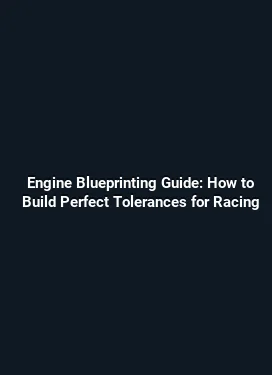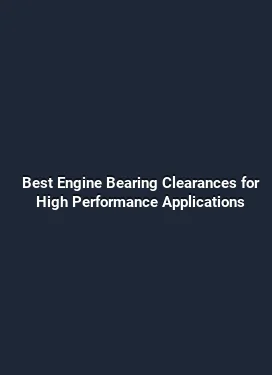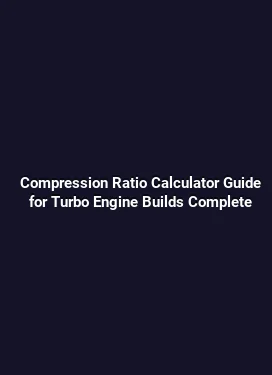Dry Sump vs Wet Sump Oil System: A Track Car Guide
Understanding the Basics of Oil Systems for Track Use

Lubrication is the lifeblood of an engine, especially under the demanding conditions found on a race track. Oil systems are designed not only to reduce friction and wear but also to manage heat, scavenge contaminants, and maintain stable pressures across a wide range of operating states. Two primary architectures dominate high-performance applications: the dry sump and the traditional wet sump. While a wet sump stores oil in the oil pan at the bottom of the engine, a dry sump uses external reservoirs and scavenging pumps to separate oil from the crankcase and deliver it at controlled pressures and temperatures. This distinction drives differences in reliability, packaging, and tuning potential on track days and endurance events.
On track cars, the goal is to sustain consistent oil pressure and temperature even during aggressive cornering, braking, and acceleration. As lateral and longitudinal loads increase, the risk of oil starvation in the sump grows if the oil pickup is immersed in air or if the oil behaves like a slosh tank. Dry sump systems mitigate this through dedicated scavenging paths and a sealed external reservoir, while wet sump configurations rely on the geometry and baffles of the pan to keep the oil supplied to the pump. Understanding these core ideas sets the stage for evaluating the trade-offs in real-world performance, maintenance, and installation complexity.
Dry Sump Anatomy and How It Impacts Engine Management
The dry sump architecture centers around a high-capacity pump system that scavenges oil from the crankcase and pushes it into an external reservoir, while a separate pump or the same dual-pump arrangement supplies oil to the engine at a controlled pressure. This separation yields several practical advantages for track cars. First, the oil pan volume can be minimized to reduce windage and improve engine breathing, while still maintaining ample oil at high RPM. Second, the external reservoir allows more effective temperature management since heat transfer can be decoupled from the crankcase and cooled through radiator-style or dedicated oil coolers. Third, the oil pressure behavior tends to be more stable under extreme accelerations and decelerations because the system isn’t limited by a shallow pan with a finite oil surface.
Engine management benefits come from predictable lubrication performance and the ability to tune oil pressure targets and flow paths independently of the engine’s internal dynamics. With dry sumps, engineers often implement additional sensors and data channels to monitor oil temperature, pressure, and the scavenging efficiency. This data supports refined maps for different track profiles, ensuring that the engine receives adequate lubrication during high-G cornering or sustained high-load sessions. In practice, the dry sump’s external reservoir also provides a convenient location for oil cooling hardware, enabling more aggressive thermal strategies that help keep viscosity within the desired operating window under race-day conditions.
One key component in dry sump systems is the scavenging circuit. A robust scavenger removes oil from the crankcase and reduces the chance of oil pooling near the crankshaft. The scavengers often feed into a low-pressure section of the reservoir, where oil can be cooled before the high-pressure pump draws it again for engine supply. The net effect is tighter control of the oil’s state, reduced crankcase pressure variation, and better protection of bearings and pistons during dynamic maneuvers. Complexity in routing, sealing, and maintenance should be anticipated when choosing this path for a production-based or purpose-built race car.
Scavenge Pumps and Crankcase Ventilation

In a dry sump, the scavge pump arrangement can include multiple stages to pull oil from different crankcase zones, along with breathers that manage crankcase pressure. Proper venting reduces the risk of oil foaming, which degrades lubrication quality and oil film strength. For track applications, the scavenging system’s efficiency is directly linked to oil temperature management, since lower residual oil in the crankcase means less energy wasted to heat up the oil as it circulates through the reservoir and cooler. Engineers often validate scavenging flow with diagnostic pressure transients during hard cornering, ensuring the pump can keep up with the engine’s demand for oil even under maximum lateral G-force.
Crankcase ventilation, sometimes integrated with the scavenging path, prevents pressure buildup that could otherwise push oil out through seals or into the intake system. A well-tuned ventilation strategy improves reliability and reduces crankcase pressure swings that might affect bearing loads during aggressive throttle input. These details matter when chasing the last percent of stability in oil pressure response under changing track conditions.
Wet Sump Design and Its Practicalities for Track Cars
The wet sump keeps oil contained within the engine’s pan and relies on internal passages and baffles to maintain lubrication during operation. The system is simpler, lighter at the base, and often more cost-effective for street-driven or many race car configurations. However, under high-speed cornering or heavy braking, the oil’s inertia can cause the oil level to shift away from the pump pickup, increasing the risk of oil starvation. Engineers mitigate this with deeper pans, improved baffle designs, and selective oil viscosities optimized for track use. The wet sump’s lower packaging complexity often translates to easier installation in existing engine bays and fewer integration challenges with aftermarket components.
Oil capacity in a wet sump is typically smaller than a well-designed dry sump reservoir, which means temperature rise can be more pronounced during prolonged sessions. Track-focused wet sump builds address this with enhanced cooling, larger capacity pans, or external oil coolers that bring the overall system closer to the thermal behavior of a dry sump. The performance implications hinge on maintaining stable viscosity and film strength across a range of engine speeds and track temperatures. When done right, a wet sump can deliver reliable lubrication with less maintenance and lower upfront cost compared to a sophisticated dry sump installation.
Return paths in a wet sump are straightforward: oil drains from the engine through the pan, returns via gravity, and is pumped back into circulation. This simplification reduces potential leak points and routing complications, but it also creates fewer degrees of freedom for optimization under extreme G-loading. Tuning a wet sump often focuses on improving pan design, ensuring adequate baffling, and selecting an oil that balances viscosity and shear strength under the expected thermal profile of track sessions.
Oil Capacity, Cooling, and Return Paths
In track settings, cooling is a critical factor for both dry and wet sump configurations. Dry sump systems commonly route oil through an external cooler before storing it in the reservoir, allowing for more aggressive cooling strategies that prevent viscosity runaway and maintain film strength. Wet sumps rely more on the engine-mounted cooling path and external radiators or coolers to remove heat from the oil after it leaves the engine and reenters the pan. The choice of cooler placement and capacity depends on ambient conditions, track length, and engine power, as well as the car’s overall cooling architecture. Operators should validate oil temperature rise per lap and correlate it with engine load to determine whether the cooling system meets the demands of the intended use.
Return paths must ensure a smooth, unobstructed flow back into the pump or reservoir. In dry sump systems, any restrictions in the scavenging lines or reservoir can bottleneck oil delivery, especially during high-G cornering. In wet sump setups, poor pan design can create air pockets or foaming, which degrade pump efficiency. Practical testing involves running standard track sessions while monitoring oil pressure curves across RPM ranges and track conditions, then iterating on baffling, line routing, and cooler sizing to achieve the desired thermal and pressure performance.
Performance Implications on Track
Oil system design has a direct impact on how an engine behaves at race track speeds. One crucial aspect is the stability of oil pressure under dynamic loading. Dry sump systems can provide more consistent pressure due to their external reservoir and multi-pump configurations, which decouple pressure from crankcase slosh. This stability translates into more predictable valve train behavior, consistent cam phasing, and steadier lifter performance during repeated high-load cycles. For engines living near the upper end of their torque curve, this predictability becomes a performance-enabling factor, especially when drivers push the vehicle into aggressive corners and late-braking zones where lubrication demands peak.
Temperature control is another major factor. Oil viscosity shifts with temperature affect film strength, shear stability, and bearing protection. Dry sump designs often enable more aggressive oil cooling, which helps maintain a thinner, more stable film at higher engine speeds and temperatures. Wet sumps rely on fewer external cooling steps, meaning heat management is more tightly coupled to the engine’s own cooling framework. In practice, teams may observe that a dry sump system can sustain aggressive track sessions with less oil temperature rise, reducing the likelihood of viscosity breakdown under repeated laps. However, the added complexity and cost of dry sumps must be weighed against the potential gains in consistency and longevity under race conditions.
Another performance dimension is packaging and weight distribution. Dry sump systems add external hardware and lines, potentially affecting center of gravity and cockpit packaging. On a well-balanced track car, the weight penalty might be offset by improved reliability and the ability to run higher oil pressures without compromising crankcase safety. Wet sumps are typically lighter and simpler to install, which can be advantageous for cars where space is constrained or where teams seek a more straightforward maintenance routine. The trade-off is often seen in how each configuration handles sustained high-G loads and the heat management required to preserve lubricant integrity over long sessions.
Installation Considerations, Reliability, and Maintenance
Choosing between a dry sump and a wet sump is not solely an engineering exercise; it also involves practical realities of installation, reliability, and ongoing maintenance. Dry sump systems demand meticulous routing of scavenging lines, careful sealing to prevent leaks in a high-G environment, and a reservoir layout conducive to efficient cooling. The payoff is improved oil supply reliability at high speeds and the potential for more aggressive engine tuning thanks to stable lubrication. But maintenance tasks—such as pump and line inspection, reservoir cleanliness, and leak checks—are more involved and require a higher level of mechanical diligence during service intervals.
Wet sumps offer simplicity and ease of maintenance. With fewer external components, there are typically fewer failure points and a more straightforward diagnostic path if an oil pressure fault arises. Reliability often hinges on pan design and proper baffling to minimize oil slosh. Regular checks focus on pan seals, baffle integrity, and oil cooler performance. For many track enthusiasts, the lower upfront cost and simpler service model of a wet sump can be decisive, particularly when the engine family and chassis are used in a broader performance regime beyond track days.
Space, Weight, and Packaging
In modern track cars, space is at a premium. Dry sump installations require space for the external reservoir, pumps, and lines that connect to the crankcase and cooler. This adds complexity to engine bay packaging, often driving a rethinking of intake routing, accessory drives, and radiator layout. Weight distribution can be influenced by the added hardware, which may affect turn-in feel and tire load transfer. When evaluating options, teams weigh the potential gains in oil control and maintenance flexibility against the packaging and weight implications for the overall vehicle dynamics.
Wet sumps, by contrast, generally involve a more compact footprint, relying on the engine’s own sump and a limited set of external lines for cooling and oil supply. The impact on vehicle packaging is typically smaller, which can simplify compliance with regulatory or competitive constraints. However, as track conditions demand more aggressive lubrication strategies, additional cooling capacity or pan enhancements may be needed to sustain oil temperature targets during long sessions.
Maintenance Regimens and Common Pitfalls
Maintenance practices differ between architectures. Dry sump systems benefit from a regular check of scavenging lines for wear or leaks, reservoir cleanliness, and pump integrity. The potential for line vibration in high-G corners means attention to mounting and line routing is essential. Periodic confirmation of oil level, pressure, and temperature at various track states helps validate the system’s performance over time. A robust maintenance plan reduces the risk of sudden lubrication failures during a race or a critical test session.
Wet sumps require routine inspection of the pan seals, baffles, and oil pickup, particularly after aggressive events that can stress gasket joints and seals. Debris and sludge in the oil can accumulate and reduce pump efficiency, so timely oil analysis and filter changes are valuable practices for track-focused builds. Ensuring the oil cooler remains free of obstructions and performs as intended under load helps maintain stable temperatures, which is especially important for engines with tight tolerances and high thermal loads.
Tuning and Mapping for Oil Systems
Optimizing the oil system for track performance involves aligning oil pressure targets, temperature ranges, and flow rates with the engine’s demanding operating envelope. Key tuning levers include selecting appropriate oil viscosity for expected track temperatures, configuring pump outputs, and calibrating pressure relief valves to maintain adequate lubrication without over-pressurizing the system. The goal is to achieve stable oil pressure across RPM and track speed bands while keeping oil temperatures within a margin that preserves viscosity and film strength across the entire lap.
Oil pressure targets should reflect the engine’s specific dynamics. Too low a pressure risks bearing wear and insufficient lubrication at high RPMs, while excessive pressure can generate unnecessary heat and contribute to parasitic losses. Track-driven applications benefit from a tuning approach that allows progressive pressure ramp with engine speed, combined with robust protection against sudden pressure drops during sudden throttle changes or aggressive braking. Mapping should also consider different track profiles, as some circuits impose greater cornering loads and longer braking phases that stress the lubrication system differently.
Sensor architecture and data logging are powerful allies in this process. Real-time monitoring of oil pressure, temperature, and flow provides insight into how the system behaves under load. Interpreting this data helps identify when a cooler capacity is insufficient or when line routing is introducing pressure losses. For many teams, dashboards that correlate oil metrics with engine torque, throttle position, and gear selection enable targeted adjustments during practice sessions, leading to a more predictable and repeatable setup for qualifying and racing scenarios.
Trend understanding in track lubrication goes beyond single-session observations. It involves recognizing how oil behavior responds to sustained high RPM, track heat, and repeated duty cycles. This knowledge informs decisions about upgrading to a dry sump when the margin to failure becomes unacceptable, or choosing a refined wet sump configuration when the baseline reliability and maintenance practicality align with the competition’s constraints. Ultimately, the tuning strategy should deliver consistent lubrication, controlled oil temperatures, and a robust boundary layer that protects the engine across the entire spectrum of track operations.
Conclusion in Practice: Choosing the Right System for Your Track Program
While both dry sump and wet sump configurations can deliver excellent lubrication under track conditions, the decision hinges on a balanced evaluation of reliability, packaging, maintenance, and cost. Dry sump systems shine in high-stress, high-G driving where oil supply stability and thermal management are paramount, often enabling more aggressive tuning and longer session life at the expense of greater installation complexity. Wet sumps offer straightforward installation, simpler maintenance, and solid performance in many track scenarios, especially where space, weight, and cost are critical constraints. A thorough assessment that includes track profiles, engine power, bay space, and service capabilities will reveal the optimal path for a specific vehicle and racing program, ensuring lubrication remains a cornerstone of performance and reliability across every lap.






